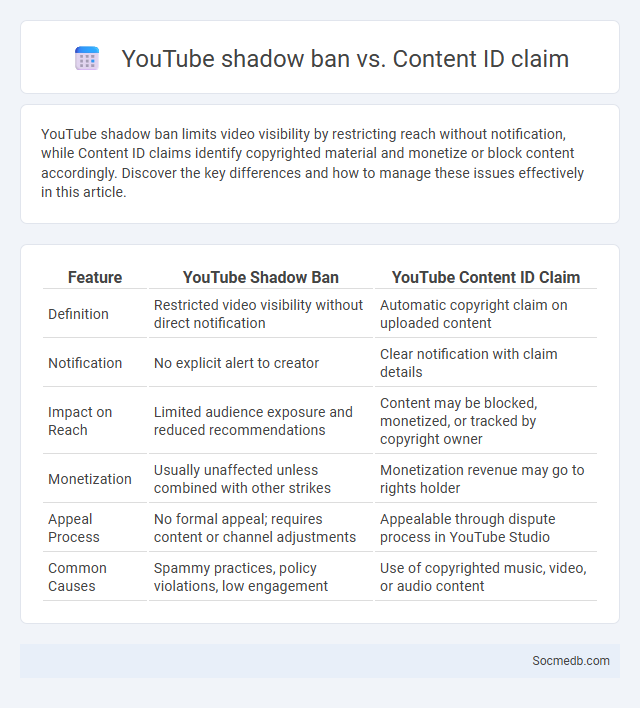
Photo illustration: YouTube shadow ban vs content ID claim
YouTube shadow ban limits video visibility by restricting reach without notification, while Content ID claims identify copyrighted material and monetize or block content accordingly. Discover the key differences and how to manage these issues effectively in this article.
Table of Comparison
| Feature | YouTube Shadow Ban | YouTube Content ID Claim |
|---|---|---|
| Definition | Restricted video visibility without direct notification | Automatic copyright claim on uploaded content |
| Notification | No explicit alert to creator | Clear notification with claim details |
| Impact on Reach | Limited audience exposure and reduced recommendations | Content may be blocked, monetized, or tracked by copyright owner |
| Monetization | Usually unaffected unless combined with other strikes | Monetization revenue may go to rights holder |
| Appeal Process | No formal appeal; requires content or channel adjustments | Appealable through dispute process in YouTube Studio |
| Common Causes | Spammy practices, policy violations, low engagement | Use of copyrighted music, video, or audio content |
Understanding YouTube Shadow Bans: Definition and Causes
YouTube shadow bans occur when your videos or comments are hidden or suppressed without notification, significantly reducing visibility and engagement. Common causes include violating community guidelines, spammy behavior, or algorithmic errors that flag your content as inappropriate or low-quality. Understanding these factors can help you adjust your content strategy to avoid penalties and maintain your channel's reach.
What is a Content ID Claim on YouTube?
A Content ID claim on YouTube is a digital rights management tool that automatically identifies and manages copyrighted material within videos. When YouTube's Content ID system detects copyrighted audio, video, or imagery, it allows the rightful owners to monetize, track, or block the content. This system helps maintain copyright protection while enabling creators and rights holders to control their intellectual property across the platform.
Shadow Banning vs. Content ID Claims: Key Differences
Shadow banning restricts user visibility on social media without explicit notification, often due to algorithmic moderation or policy violations, while Content ID claims specifically address copyright infringement by identifying and managing copyrighted material. Shadow banning impacts overall account reach and engagement subtly, whereas Content ID claims can lead to content removal, monetization shifts, or legal disputes centered around intellectual property rights. Understanding these mechanisms is crucial for content creators to navigate platform policies, protect their digital presence, and maintain audience interaction effectively.
How to Identify a YouTube Shadow Ban
Identifying a YouTube shadow ban involves monitoring sudden drops in video views, likes, or comments without clear reasons, signaling restricted content visibility. You can check this by searching for your videos in incognito mode or from different accounts to see if they appear in search results or recommendations. Tracking engagement analytics and community feedback helps confirm if your channel experiences shadow banning on YouTube.
Common Triggers for Content ID Claims
Content ID claims are commonly triggered by copyrighted music, video clips, and images You use in your social media posts without proper authorization. Automated systems scan your uploads for matches against a vast database of protected content owned by major media companies and independent creators. Understanding these triggers helps you avoid violations and maintain the integrity of Your social media presence.
The Impact of Shadow Banning on YouTube Creators
Shadow banning on YouTube significantly disrupts content creators' visibility by restricting their videos' reach without clear notifications, leading to decreased viewer engagement and revenue loss. Algorithms involved in shadow banning alter search rankings and recommendations, preventing creators from connecting with their target audience effectively. This practice undermines creators' growth opportunities and raises concerns about transparency and fairness within the platform's content moderation policies.
Resolving Content ID Claims: Steps and Best Practices
Resolving Content ID claims on platforms like YouTube involves swiftly identifying the specific content flagged and reviewing the claim's legitimacy through the platform's resolution tools. Creators should gather evidence of ownership or fair use, such as licenses or original footage, to submit counter-notifications or dispute claims effectively. Maintaining organized records of content origins and timely communication with claimants enhances the chances of successful claim resolution while avoiding channel strikes or monetization loss.
Myths and Facts About YouTube Shadow Banning
YouTube shadow banning is often misunderstood, with the myth that it completely hides videos from all users being false; in reality, it limits video visibility by reducing recommendation placement and search rankings. Many creators mistakenly believe shadow banning is a deliberate punishment, but YouTube's algorithm instead prioritizes content based on engagement metrics and community guideline compliance. Fact-based analysis shows that content flagged by YouTube's automated systems or user reports may experience restricted reach, rather than total removal, impacting views and channel growth subtly.
Protecting Your Channel from Bans and Claims
Protecting your social media channel from bans and claims requires strict adherence to platform guidelines and copyright laws, ensuring all shared content is original or properly licensed. Implementing proactive monitoring tools helps identify potential violations early, enabling timely resolution before penalties occur. Consistently reviewing updates from platforms like YouTube, Facebook, and Instagram minimizes risk by aligning content with evolving policies and community standards.
Future Trends: YouTube Policy Changes and Content Moderation
YouTube is implementing stricter content moderation policies to combat misinformation and harmful content, including enhanced AI-driven detection tools and increased transparency in content removal decisions. Future trends indicate a shift toward more personalized content regulation frameworks, empowering creators with clearer guidelines while maintaining platform safety. These policy changes aim to balance user engagement with responsible content dissemination, reflecting growing regulatory pressures worldwide.
 socmedb.com
socmedb.com